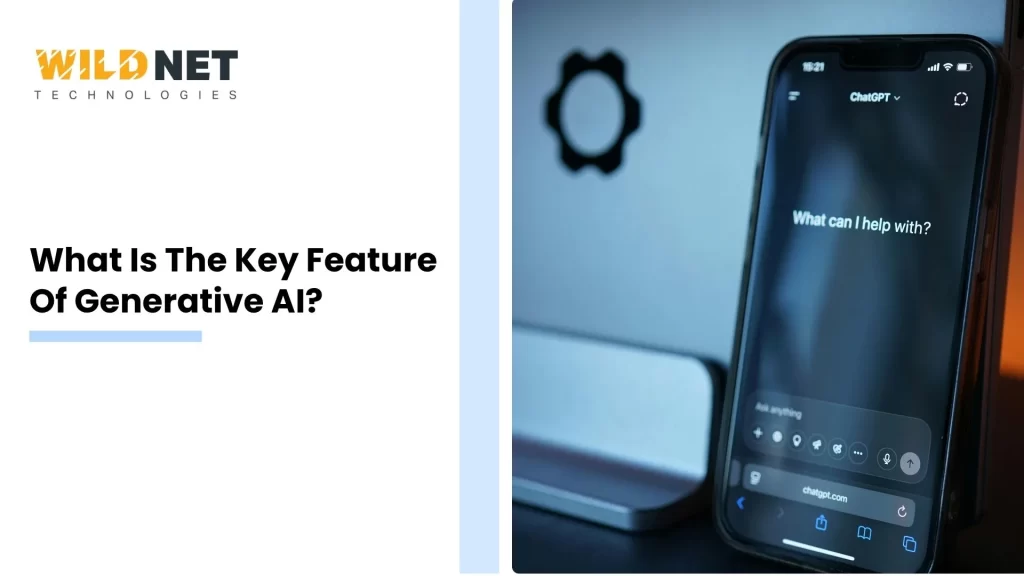Generative AI has become a buzzword in technology and innovation circles. Its sudden rise to prominence is not without reason; it represents a paradigm shift in how we think about creativity and automation. But what exactly is it, and what makes it so revolutionary? This article will explore the key feature of generative AI, delve into the concept of generative models, and understand how they are reshaping various industries. Through this exploration, we will uncover the transformative potential of generative AI and its implications for the future.
Understanding Generative AI: Creating New Realities Through Intelligent Algorithms
Generative AI refers to a subset of artificial intelligence that focuses on creating new content. This can include anything from text and images to music and even entire virtual environments. The essence of generative AI lies in its ability to learn and adapt from existing data, enabling it to produce content that is both novel and reflective of the underlying patterns within the data. Unlike traditional AI systems that follow explicit instructions, generative AI systems learn patterns from existing data and use these patterns to generate new, original content. this capability to autonomously generate content positions generative AI as a cornerstone of future technological advancements.
At the heart of generative AI are generative models. These are sophisticated algorithms that learn from a dataset and then use this knowledge to generate new data points that resemble the original data. The most commonly used generative models include Generative Adversarial Networks (GANs), Variational Autoencoders (VAEs), and Transformer-based models. Each of these models has unique mechanisms and applications, making them versatile tools in the generative AI toolkit. Through continuous learning and adaptation, these models can refine their output over time, ensuring that the generated content remains relevant and accurate.
“Generative Adversarial Networks (GANs): The Duel Behind Realistic AI Creations
GANs are a class of machine learning frameworks invented by Ian Goodfellow and his colleagues in 2014. They consist of two parts: a generator and a discriminator. The generator creates new data instances, while the discriminator evaluates them. The goal is for the generator to make data so convincing that the discriminator cannot distinguish between real and generated data. This adversarial process not only enhances the quality of the generated content but also pushes the boundaries of what is possible with machine learning. GANs have been pivotal in applications such as image generation, where they have achieved remarkable results in producing photorealistic images from scratch.
Variational Autoencoders (VAEs): Probabilistic Models for Diverse and Efficient Data Generation
VAEs are another type of generative model that uses a probabilistic approach to generate new data. They encode input data into a compressed representation, then decode it back into data that resembles the original input. This process allows VAEs to generate new data points by sampling from a learned latent space. The probabilistic nature of VAEs makes them particularly effective in tasks that require a degree of randomness, such as generating diverse variations of an input. VAEs have found applications in fields like image compression and enhancement, where maintaining data quality while reducing file size is essential.
Transformers and GPT: Powering Human-Like Language Generation in AI
Transformers, such as GPT (Generative Pre-trained Transformer), have recently gained popularity for their ability to generate human-like text. These models use a mechanism called self-attention to weigh the importance of different words in a sequence, allowing them to create coherent and contextually relevant text. The versatility of transformers extends beyond text generation, as they are also used in natural language processing tasks like translation and summarization. The ability of transformers to understand and generate language with high accuracy has made them invaluable in the development of conversational AI systems.
The Transformative Power of Generative AI: Applications, Impact, and Ethical Considerations
The key feature of generative AI is its ability to mimic human-like creativity and innovation. By learning from vast datasets, these AI systems can generate content that is not only new but also highly original and creative. This unique capability has far-reaching implications across various sectors, enabling businesses to leverage AI for creative problem-solving and innovation. The integration of AI-generated creativity into traditional workflows is transforming industries, offering new avenues for artistic expression and product development.
Generative AI is being applied in numerous fields, revolutionizing how businesses operate and people interact with technology. The adaptability of generative AI models allows them to be tailored to specific industry needs, providing solutions that were previously unimaginable. From automating repetitive tasks to generating entirely new forms of content, generative AI is redefining industry standards and pushing the boundaries of what is possible.
Generative AI is making waves in the art world by creating stunning visuals and designs. Artists and designers use these tools to explore new creative possibilities and generate artwork that blends human creativity with machine precision. This collaboration between man and machine has led to the creation of entirely new art forms, challenging traditional notions of authorship and creativity. The ability of generative AI to produce intricate designs and patterns has also found applications in fields like fashion and architecture, where innovation is key.
In healthcare, generative AI is being used to design new drugs and discover treatments. By simulating molecular structures and interactions, AI can help scientists identify potential drug candidates faster and more efficiently than traditional methods. This acceleration in drug discovery has the potential to revolutionize healthcare, making treatments more accessible and tailored to individual needs. Additionally, generative AI models are being used to analyze medical images, improving diagnostic accuracy and enabling personalized treatment plans.
The entertainment industry is leveraging generative AI to create content such as music, movies, and video games. For example, AI can compose music that matches a specific mood or generate realistic environments for video games and films. These capabilities enhance the quality of entertainment and enable creators to experiment with new genres and styles. The integration of AI in content creation is democratizing the entertainment industry, allowing independent creators to produce high-quality content with limited resources.
Generative AI is transforming marketing by personalizing content and crafting unique advertisements tailored to individual preferences. This allows companies to engage with their audience in a more meaningful way, improving customer satisfaction and loyalty. The ability to analyze consumer data and generate targeted content is enhancing marketing strategies, making them more efficient and effective. As a result, businesses are seeing increased returns on their marketing investments and stronger brand loyalty.
While generative AI offers incredible potential, it also presents challenges and ethical concerns that need addressing. The rapid advancement of this technology has outpaced the development of regulatory frameworks, raising questions about accountability and governance. Addressing these challenges is crucial to ensuring that generative AI is used responsibly and ethically.
Generative models require large datasets to learn from, raising concerns about data privacy and security. Ensuring that personal information is protected and used responsibly is crucial.
To maintain user trust, companies must implement robust data protection measures and adhere to regulations such as GDPR. Ethical data use is a significant challenge, as the potential for misuse and exploitation remains a concern.
The Future of Generative AI: Innovation, Ethics, and the Road Ahead
As generative AI can create highly realistic content, distinguishing between real and AI-generated material becomes challenging. This raises the issue of misinformation and the potential for AI-generated content to deceive or manipulate audiences. The proliferation of deepfakes and other synthetic media has highlighted the need for tools and techniques to verify content authenticity. Combatting misinformation requires a collaborative effort between technologists, policymakers, and the public to ensure the integrity of information.
Generative AI is not just a technological trend—it’s a transformative force reshaping how we create, communicate, and solve problems. The key feature of generative AI, its ability to generate original and context-aware content, plays a central role in this transformation. As it evolves, its integration with industries will spark breakthroughs we can’t yet imagine. However, generative AI models can inadvertently learn biases present in the training data, leading to biased outputs. With its vast potential comes the need for responsible use, guided by ethics and transparency.
Generative AI is still in its early stages, but its potential is enormous. As technology advances, we can expect even more sophisticated generative models that produce highly realistic and creative content. The continuous evolution of generative AI will lead to innovations that are currently beyond our imagination, reshaping industries and society.
Researchers are continually working on improving generative models, making them more efficient and capable of handling complex tasks. Breakthroughs in AI research will likely lead to new applications and innovations across various sectors. The development of more powerful and efficient algorithms will enable generative AI to tackle increasingly complex challenges, driving progress in areas such as autonomous systems and artificial general intelligence.
Generative AI will increasingly be integrated with other emerging technologies, such as augmented reality (AR) and virtual reality (VR), to create immersive experiences that blur the line between the digital and physical worlds. This convergence of technologies will enable the creation of new experiences and applications that enhance human capabilities and transform industries. The potential for generative AI to improve human-computer interaction is vast, offering new ways for individuals to interact with technology.
As generative AI continues to evolve, ethical considerations will play a more prominent role in its development. Ensuring that AI systems are transparent, accountable, and aligned with human values will be crucial for their widespread adoption and success. The development of ethical guidelines and standards will be essential to guiding the responsible use of generative AI.
Collaboration between stakeholders, including researchers, policymakers, and industry leaders, will be necessary to navigate the ethical challenges posed by this transformative technology.
Generative AI is a powerful technology that is transforming industries and reshaping our world. Its key feature—mimicking human-like creativity and innovation—opens up a world of possibilities for businesses and individuals alike. As we continue to explore the potential of generative AI, it is essential to address the challenges and ethical considerations that come with it, ensuring that this technology benefits society as a whole.
The future of generative AI holds promise and potential, and its responsible development will shape technological progress in the coming years.
5 FAQs
1. What makes generative AI different from traditional AI?
Traditional AI follows set rules to analyze data or make decisions. At the same time, generative AI learns patterns in data to create new, original content, such as images, music, or writing, making it far more creative and adaptive.
2. How is generative AI expected to impact industries soon?
Generative AI is set to revolutionize industries like healthcare, marketing, entertainment, and design by automating creative processes, enhancing personalization, and enabling the rapid development of innovative solutions.
3. What ethical concerns surround generative AI?
Primary concerns include misinformation (e.g., deepfakes), bias in AI outputs, misuse of generated content, and lack of transparency. Addressing these requires strong ethical frameworks and responsible AI development.
4. Will generative AI replace human creativity?
Not entirely. Generative AI is best viewed as a collaborative tool that enhances human creativity rather than replaces it, helping creators and professionals work faster and explore more possibilities.
5. How can businesses responsibly adopt generative AI?
Companies should ensure transparency, fairness, and security in AI use, regularly audit models for bias, and follow evolving ethical guidelines to deploy generative AI safely and effectively.
Conclusion
Generative AI is not just a technological trend—it’s a transformative force reshaping how we create, communicate, and solve problems. The key feature of generative AI, its ability to generate original and context-aware content, plays a central role in this transformation. As it evolves, its integration with industries will spark breakthroughs we can’t yet imagine. However, with its vast potential comes the need for responsible use, guided by ethics and transparency. Collaboration across sectors is essential to ensure that generative AI benefits society. For businesses seeking to explore this technology through digital innovation, Wildnet Technologies stands out as one of the best digital marketing companies in India, offering expert AI-driven solutions to elevate brand impact and growth.
Read More
Generative Engine Optimization (GEO): Enhancing AI-Driven Content for Search
How Can Generative AI Improve Seo Strategies for Brands?
ChatGPT, Google Bard, And Anthropic Claude Are Examples Of Which Type Of Generative AI model?






